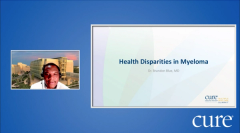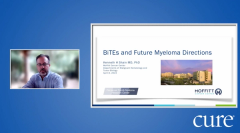
Educated Patient® Multiple Myeloma Summit Health Disparities Presentation: April 8, 2023
Watch Dr. Brandon Blue, from Moffitt Cancer Center, discuss health disparities during the CURE Educated Patient Multiple Myeloma Summit.
Episodes in this series

Patients with multiple myeloma are faced with undeniable disparities related to their health, treatment and enrollment in clinical trials, according to Dr. Brandon Blue.
When compared to patients of other races, individuals of African descent have twice the incidence of both myeloma and monoclonal gammopathy of undetermined significance (MGUS), an early precursor condition of abnormal protein in the blood, he explained at CURE®'s Educated Patient® Multiple Myeloma Summit.
Blue, who chaired the summit and is also a clinical instructor in the Department of Malignant Hematology at Moffitt Cancer Center, centered on what he referred to as the “four Ts” of disparities for patients with myeloma: treatments, trials, transplants and CAR-T cell therapy.
For example, African American and Hispanic patients have significantly longer periods of time from diagnosis to the beginning of treatment compared with White patients – 5.2 and 4.6 months versus 2.7 months, respectively.
Hispanic patients also had the highest median number of days to their first dose of Velcade (bortezomib) at 117 days, which was more than double the time of any other race, and the lowest utilization of stem cell transplants at 1.9%, according to data from the SEER-Medicaid database, Blue explained. Utilization of stem cell transplants, which within the first year after diagnosis has been associated with better overall survival (the time from treatment to patients being alive), increased over time for all groups of patients except African Americans, he added.
“It’s (a situation of) basically knowing that you have the disease but not having access to the medicines to do something about it,” Blue said during his presentation. “And so, I think that’s where I think a lot of the research and a lot of the education and things need to happen. We need a better program to make sure people are getting the drugs that they need. Because unfortunately, we just see so many differences when it comes to African Americans and Hispanics.”
Regarding disparities among patients treated with CAR-T cell therapy, Blue cited data showing that Black patients were more likely to be female and have higher levels of baseline inflammatory markers, such as C-reactive protein and ferritin, and they are more likely to develop cytokine release syndrome, stay longer in the hospital and experience severe, prolonged cytopenias. While no racial or ethnic differences in overall survival were observed, Hispanic and Black patients combined exprience worse progression-free survival (the time from treatment until disease worsening or progression) compared with White patients (5.9 months versus 9 months) – which, according to Blue, was likely caused by worse overall response rates seen among Hispanic patients.
Multiple myeloma is the second most common blood cancer, with more than 32,000 new cases reported in 2020 alone and more than 131,000 patients living with the disease or in remission in the United States. It’s most frequently diagnosed in patients between 65 and 74 years old.
“Typically, just by having birthdays, it puts you at risk for having myeloma,” Blue said.
African American people have twice the myeloma incidence than the national average – 17 Black men and 12.9 Black women per 100,000 made up new cases of the disease between 2015 and 2019, compared with 8.8 men and 5.9 women in the overall population, according to data from the National Cancer Institute’s Surveillance, Epidemiology and End Results Program.
However, Blue noted that the large gaps in myeloma care “go away when all things were equal.” As proof, he highlighted the findings of a study of more than 15,000 patients in the Veterans Administration health care system between 2000 and 2017, which showed that, with no racial disparity regarding overall use of novel agents or stem cell transplants, African-American patients had a longer median overall survival period compared with White patients (7.07 years versus 5.83 years).
Patients of minority races with myeloma have experienced less of an increase in population-level survival in the early 21st Century compared with White patients, Blue stated; however, when enrolled in clinical trials, minority patients have similar survival rates to those of White patients.
Less than half of the clinical trials leading to drug approvals between 2008 and 2018 reported on non-White races. Therefore, Blue advocated for appropriate representation in myeloma clinical trials “to ensure that new drugs will work equally as well” for Black patients as for those of other races.
The lack of representation can likely be chalked up to a number of reasons, Blue explained, noting that there is a lack of education around trail eligibility, and that the medical community sometimes fails to advertise clinical trials as a way to help people.
“Just in general, overall, we do a bad job of really letting each side know how we can mutually benefit from research,” Blue said. “And I think, hopefully, we can do a better job. But I think that's the big problem.”
For more news on cancer updates, research and education, don’t forget to













